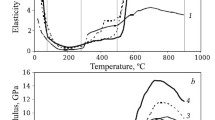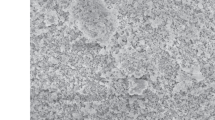The urgency of the problem of shrinkage phenomena during hearth firing, contributing to joint opening and crack formation, is demonstrated. Contemporary methods and means of studying expansion/shrinkage of hearth mixes during firing are analyzed. Expansion/shrinkage of hearth mixes, differing in the ratio of the carbon component (anthracite) and artificial graphite within their composition, is investigated. It is established that shrinkage phenomena decrease in a series from anthracite to graphite-anthracite. Studies show that the difference in the scale of linear changes during structural shrinkage is quite significant, i.e., about 20%. It is noted that minimization of shrinkage phenomena contributing to opening of joints and crack formation is one of the factors for reducing the risk of leakage at the bottom of a cell. In this connection it is advisable to optimize the shrinkage rate of hearth mixes during firing in the stage of structural adjustment taking account of operating conditions.






Similar content being viewed by others
Notes
TU 48-12-25–90. Anthracite hearth mix; intro. 01.01.1991. — MTK 109 “Electrode production” AO Ural Electrode Institute, OKP 19 1441, Group I 39; TU 48-12-57–89. Cold ramming mix for aluminum electrolyzers; intro. 09.01.1989. MTK109 “Electrode production” AO Ural Electrode Institute, OKP 19 1441, Group I 33; TU 1914-109-075–2001. Hearth mixes for aluminum electrolyzers; intro. 01.01.2002. — MTK 109 “Electrode production” AO Ural Electrode Institute, OKP 19 1440, Group I 39; TU 1914-027-136-84336–2013. Low-shrinkage cold-ramming mix. — ZAO ÉNERGOPROM — Novosibirsk electrode plant; TU 1914-071-05785218–99. Carbon hearth mix (cold-rammed); intro. 11.19.1999. OAO KrAZ.
TU 1913-109-021–2003. Hearth blocks for aluminum electrolyzers. Intro. 07.01.2003. MTK 109 “Electrode production”, OAO Ural Electrode Institute, Group I 31. URL: http://docs.cntd.ru/document/415950625 (access date 05.14.2019).
References
M. Meier, J. Wyss, and R. Perruchoud, “(R&D Carbon Ltd, Sierre, Switzerland). Testing of anodes, cathodes and ramming paste: a must for smelters and producers,” Non-Ferrous Metals & Minerals: Book of Papers of the Ninth International Congress (Krasnoyarsk, Russia, September 11 – 15 (2017). — Krasnoyarsk : Science and Innovation Center Publishing House (2017).
M. Sorlie and H. Oye, Cathodes in Aluminum Electrolysis; 3rd ed., Aluminum Verlag GmbH, Düsseldorf (2010).
V. Buzunov, S. Zykov, and S. Khramenko, “Developing a technique to estimate the anode paste impregnation degree,” Tsvetnye Metally, No. 11, 51 – 55 (2018).
T. V. Butakova, E. A. Zjulkovskaya, G. S. Bleskin, et al., “Simulation of baking conditions and start-up of the aluminium electrolytic cells and their effect on the operating performance of cold ramming paste,” Journal of Siberian Federal University. Engineering & Technologies, No. 10 (7), 874 – 880 (2017).
M. Vohidov, A. Murodiyon, and B. Azizov, “The main properties of cold-rammed bottom mass aluminum cells,” News of the academy of sciences of the republic of Tajikistan. Department physical, mathematical, chemical, geological and technical sciences, 1 3 (152), 70 – 76 (2013).
ISO 14428:2005 (E). “Carbonaceous materials for the production of aluminium—Cold and tepid ramming pastes—Expansion/shrinkage during baking”. First edition (2005).
ISO/FDIS 14428:2019 (E). “Carbonaceous materials for the production of aluminium — Cold and tepid ramming pastes — Expansion/shrinkage during baking”. Voting begins on: 2019.07.28.
GOST R ISO 14428–2016. Carbonaceous materials for the production of aluminium. Cold and tepid ramming pastes. Expansion/shrinkage during baking. Introduction date 07.01.2017.
G. D. Apalkova, I. I. Prosvirin, A. N. Selesnev, et al., “Design, development and production of cathode blocks for new generation of high power electrolyzers,” 1st World Conference on Carbon Eurocarbon, Berlin, Germany 9 – 13 July 2000.
G. D. Apalkova, “Rammability of aluminum electrolyzer’s carbon pastes,” Tsvetnye Metally, No. 6, 59 – 62 (2017).
V. A. Shaposhnikova and M. S. Gorpienko, editors, Practical Guide for Quality Control of Raw Materials for Preparing Carbon-Graphite Materials [in Russian], Min. Tsvet. Met SSSR, Moscow (1982).
GOST R ISO 20202–2016. Carbonaceous materials for the production of aluminium. Cold and tepid ramming pastes. Preparation of baked test pieces and determination of loss on baking); intro. 01.07.2017. 13. GOST R 57613 – 2017. Graphite electrodes and nipples. Specifications; intro. 08.01.2018.
Article produced with support of the RF Government (Resolution 211 of 03.16.2013), agreement No. 02.A03.21.0011.
Author information
Authors and Affiliations
Corresponding author
Additional information
Translated from Novye Ogneupory, No. 3, pp. 61 – 64, March, 2020.
Rights and permissions
About this article
Cite this article
Apal’kova, G.D. Expansion/Shrinkage of Hearth Mixes During Firing. Refract Ind Ceram 61, 188–191 (2020). https://doi.org/10.1007/s11148-020-00453-9
Received:
Published:
Issue Date:
DOI: https://doi.org/10.1007/s11148-020-00453-9




